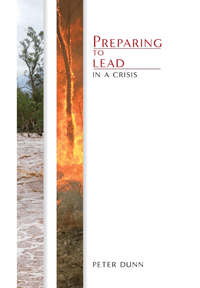 Published by Barrallier Books Pty Ltd, trading as Echo Books
Published by Barrallier Books Pty Ltd, trading as Echo Books
Author: Peter Dunn
ISBN: 9780648202585
Crises can occur at any time and in any organisation or community. At such times, leaders at all levels are tested and very few would say that, on reflection, they did not learn from such a difficult experience. Good leaders are always learning.
Australia has experienced complex and increased frequency of emergencies. Leadership during these emergencies is critical to supporting the community and emergency management organisations through the response and recovery efforts. The nature of emergencies means there is likely to be periods of chaos and uncertainty. Reducing this period of chaos through ensuring leaders have the skills and tools to effectively lead in a crisis is what Peter Dunn’s Preparing to Lead in a Crisis is focused on. Dunn walks the reader through a practical guide supported by Australian case studies to provide techniques to support the contributors to a leader’s success during emergencies and crisis of leadership skills, planning, using information and intelligence and resource allocation.
Peter Dunn began his career in the Australian Army and retired in 2002 as a Major General. Dunn then worked in the public sector before moving into private enterprise gaining extensive experience in crisis management techniques, emergency management and capability development.
The book discusses senior leaders and planning providing guidance on framing events, thinking strategically, planning and testing plans. Dunn uses leadership theories from existing literature and experiences from Australian events to provide useful techniques for leaders to consider when preparing for and understanding the initial stages of an event. He specifically discusses the ambiguity that occurs at the initial stages of an event and the importance of paying attention to the signals that indicate that the event is not what is expected. Regular contact, accessibility and presence with staff is discussed through being visibly present and removing barriers within organisational hierarchies. This part ends with a discussion on effective planning processes and the importance of worst-case scenario planning and stress-testing plans including the use of capabilities such as ‘red teaming’.
Organisational leadership techniques are covered in part two that covers the distributed leadership model, role clarity, intelligence and resourcing. Dunn discusses the importance of building trust and confidence within teams and supporting the distributed leadership model to allow senior leaders to remain at the strategic level. Capturing, analysing and using intelligence is then discussed, particularly the importance of understanding intelligence sources and information reliability together with continuing to assess for signals. The final chapter is based on resourcing and interoperability to ensure leaders understand what capability the organisation has prior to an event, what can be used during an event and where the gaps are.
Reflect on the senior leaders that you have admired most. It would be surprising if there were any on your list that were not approachable and did not listen to options that you presented. In a high-pressure situation where you have presented an option to your senior leader and they accepted it, and thanked you for your efforts, how did you feel about the leader?
The book concludes with a discussion on senior leaders’ behaviours during a crisis including the characteristics of being approachable, sensibly optimistic and calm. Approachable relates to a leader who has intimate knowledge of the planning process. Work involved in implementing plans effectively means managing resources and collaborating with others to be effective. Balancing optimism and realism is a challenge. Dunn discusses how leaders are sensibly optimistic and show they understand rising challenges. Having an in-depth understanding of the plans and available capabilities prior to the event is critical to the success of achieving this. Dunn also covers being calm and having emotional intelligence to assist effective functioning and leading in high-pressure situations.
As a supplementary resource for crisis and emergency management personnel, people in leadership roles and those striving to be future leaders in the field, this book provides a range of techniques that support leaders during crisis and emergency events.


